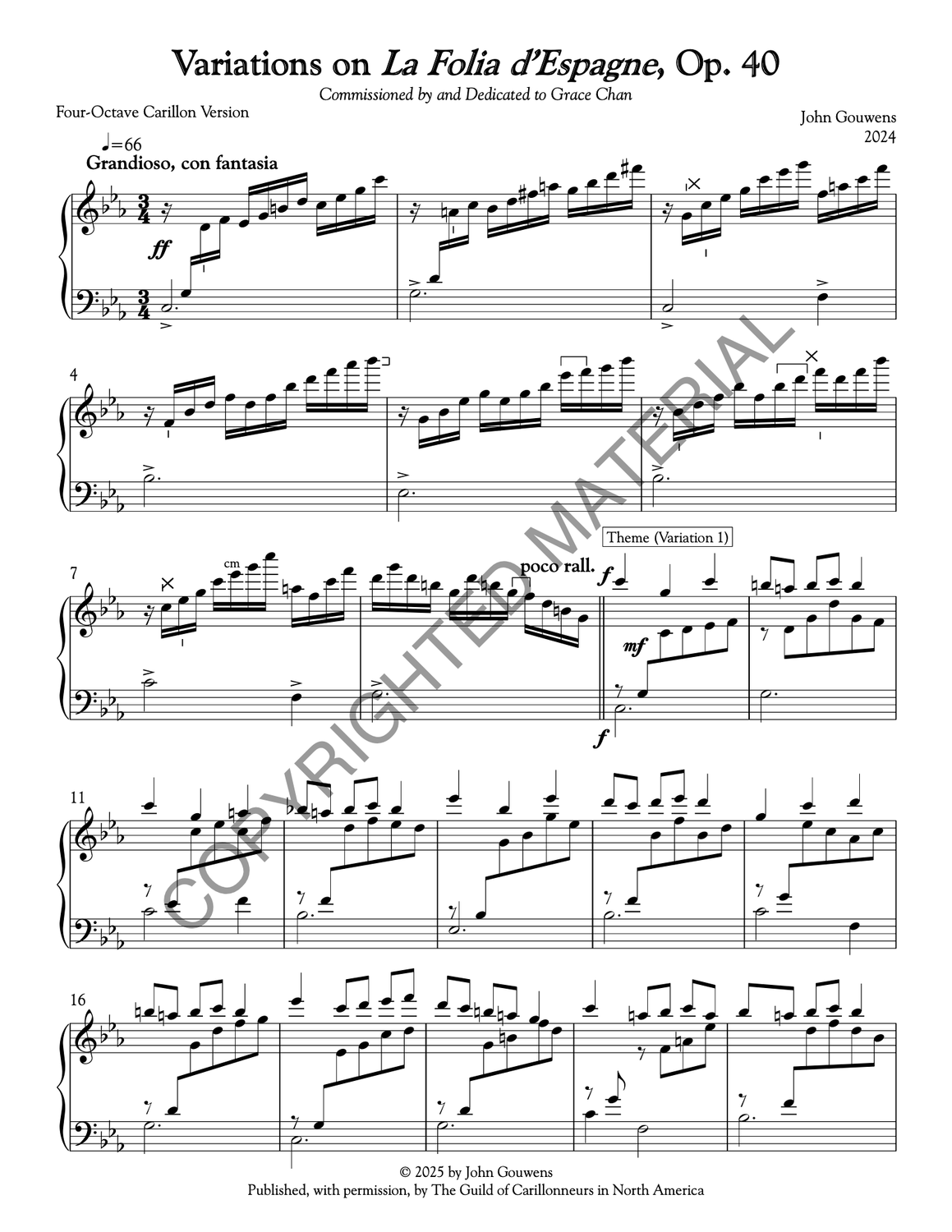
Variations on "La Folia d'Espagne"
Program notes
La Folia d'Espagne (the Folly of Spain) is a theme (most often a harmonic pattern, but sometimes a melody) that has inspired composers over some 330 years to write 150 pieces based on it! Sometimes it is a pattern of just eight measures, but later versions of it are sixteen measures long. Apparently, the theme first appeared in Portugal in the 17th century, though from its title, it has normally been associated with Spain. I have heard numerous pieces based on this theme, though my strongest impression is a keyboard partita (variations) by Italian organist and composer Bernardo Pasquini (1637–1710). Pasquini's partita used both the harmonic pattern and a melody he applied to it. Occasionally, I've thought about doing something with that theme for a composition, but the genesis of this piece was that Grace Chan, a student in Sydney, Australia, who I have been teaching carillon to for quite awhile, approached me about hiring me to write a piece based on that theme that would take full advantage of the 54-bell carillon at the University of Sydney. I immediately realized I could have a whole lot of fun writing something like that, so I not only accepted right away, but I actually completed the first draft (already six minutes' worth of music) over just five days!
I recognized that if I used both the harmonic progression and the melody that Pasquini had applied to La Folia that I would have far more flexibility in what I did with the variations. In particular, variations 6 and 7 at least allude to the melody but depart quite radically from the original harmonic pattern. It all works together, though, since the melody and the chord progression are indeed closely related. Here's a quick outline of what happens in the piece: A free introduction outlines the harmonic pattern (in just eight measures) as a florid introduction to the work. "Variation One" is actually a statement of the harmonic pattern together with the Pasquini melody, with a middle voice adding some further embellishment. Variation 2 is a bit more ornamented, and while it follows the harmonic pattern carefully, the melody is only hinted at somewhat. Variation 3 is more ornate, actually, but it does incorporate the Pasquini melody quite prominently. Variations 4 and 5 use various types of arpeggio figurations for rather dramatic variations on the harmonic pattern. (The melody isn't really used at all.) In Variation 6, I use the Pasquini melody, now in the bass, accompanied by figurations based on octatonic harmonizations of the diatonic melody, in the style of many hymn preludes by Roy Hamlin Johnson. (Johnson was not only a composer I admired, but also a good personal friend.) The biggest departure from the original harmonic pattern is Variation 7. At first, fragments of the Pasquini melody are employed above a common Flamenco harmonic pattern. Later in this variation, I abandon the theme entirely in favor of following the lead of improvisatory Flamenco music. (After all, this is music with an obvious Spanish connection.) The eighth and final variation brings back not only the original harmonic pattern, but also the Pasquini melody, tying all the elements used earlier back together again. This leads to a short cadenza (free, improvisatory passage) which brings the work to a close. My sense was that I had reached the ideal length for a piece based on these materials. As one of my teachers once said, "A good improvisation can turn into a bad one in a hurry by not knowing when to quit." That’s definitely equally applicable to composition!
The original piece is written for 53-bell G-compass carillons (think Canberra, University of Kansas, Washington Cathedral, etc.). I have another version of the cadenza that specifically takes advantage of the low A-flat that Sydney has. (That would also be useful at Yale, University of Chicago, University of California at Berkeley, and a select few others.) The GCNA is publishing this piece in 4-octave and 53-bell versions. I'm retaining the copyright, so that I may freely share versions I have adapted for three octaves, "grand carillons" that include a low A-flat, and others. Please contact me individually about those. For my own purposes, I'll be playing at least three of these versions myself at various venues. I hope that many of you find this piece as useful and fun as I have! It was a blast to write!!
—John Gouwens (Culver, Indiana, August 16, 2024)

![[PDF] Variations on "La Folia d'Espagne" [PDF] Variations on "La Folia d'Espagne"](https://d2j6dbq0eux0bg.cloudfront.net/images/9481258/4957943455.png)